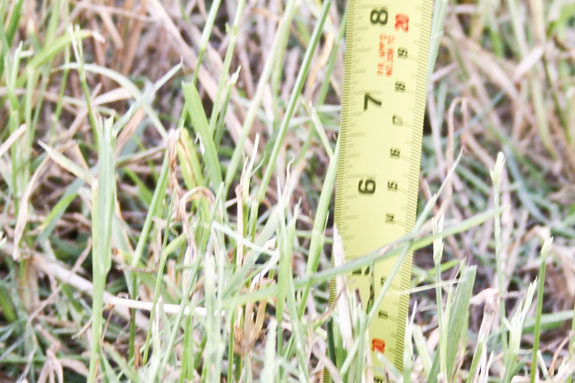The selection of your grazing intensity is more important than any other single grazing management decision.
Different grasses have different growth forms. Some are sod types, like bermudagrass; others are bunch grasses like the small grains (oats, rye, wheat) or summer annuals like pearl millet. Sod-forming grasses store the reserve energy in thick rhizomes or underground stems right under the soil level.
In these sod-type (decumbent) grasses, tillers grow through the leaf sheath to form a sod that spreads with further development of rhizomes and runners (stolons), which is typical of bermudagrasses. The bud sites or growing points in sod types are located low in the canopy, allowing the plant to be persistent under close grazing or defoliation.
The lower the budsites and the thicker the rhizomes, the greater the ability of the plant to withstand more intense or low stubble height defoliation.
Different from the sod-forming grasses, the bunch grasses have a compact arrangement of their tillers, which grow within the sheath of the grass, keeping the growing points elevated and not so close to the ground. A rule of thumb for bunch-type forages is to leave a good portion of the above-ground basal growth. In many cases this represents the lower third of the plant.
It is important to know that within grass types some will grow more upright than others, and this growth habit dictates how to manage the stubble height for the different grasses.
In some cases, even within a grass species there will be differences among cultivars relative to their stubble height management. For example, hybrid bermudagrass, Tifton 85, has a more upright growth than common bermudagrass.
Or in the case of bahiagrasses, the cultivars Tifton 9 and UF-Riata have a more upright growth than Argentine. The cultivars with more upright growth are less tolerant of closer defoliation.
There is plenty of evidence that shows that when pastures are overstocked and overgrazed (regardless of growth type), the plant reserves are depleted; if close grazing continues for too long the plant will not have sufficient energy for re-growth. The root system is affected, resulting in weak plants, and possibly, eventual loss of the stand will occur.
The location of the tillers and growing buds influences how accessible they are to livestock, and it also affects the ability to re-grow after defoliation. It is the combination of growth form and physiological type that determines the plant capacity to recuperate after being defoliated and dictates why some grasses should be left with a higher stubble height than others.

Table 1 shows the minimum stubble height recommended for the main forage plants in Florida and the deep South based on use. You will notice that recommended stubble heights are slightly lower under rotational grazing compared to continuous stocking for the same forage plant. Under rotational stocking, the plants have rest periods that allow for forage accumulation. Under continuous stocking the animals have unlimited and uninterrupted access to the grazing area.
A general rule to follow is that the more stressful the conditions are, such as heavy stocking rates, colder or warmer temperatures in atypical seasons, or prolonged drought, the more conservative the management of stubble height should be.
Preventive management, such as proper stubble height, allowing a rest period until the plant can restore adequate reserves, destocking when in extreme drought conditions or closing of pastures when they have reached the critical stubble height, will save you from facing the crisis that comes with the combination of degraded pastures – no feed, low cash – and will save you the money needed for total renovation of pastures and weed control usually associated with overstocking. FG

Yoana Newman
Forage Extension
University of Florida








